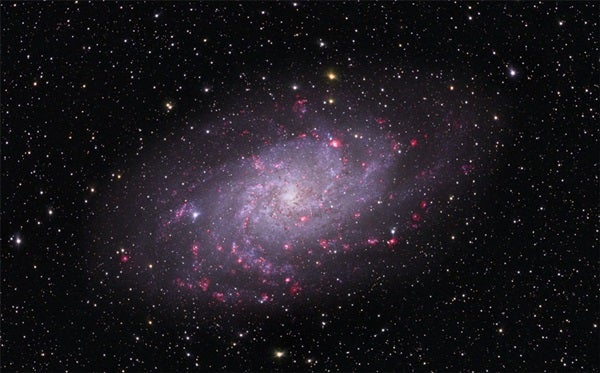Astronomers know quite a bit about molecular clouds. They consist mainly of hydrogen molecules — unusual in a cosmos where conditions are rarely right for hydrogen atoms to bond together into molecules. And if scientists trace the distribution of clouds in a spiral galaxy like our own Milky Way Galaxy, they find that they are lined up along the spiral arms.
But how do those clouds come into being? What makes matter congregate in regions a hundred or even a thousand times denser than the surrounding interstellar gas?
One candidate mechanism involves the galaxy’s magnetic fields. Everyone who has seen a magnet act on iron filings in the classic classroom experiment knows that magnetic fields can be used to impose order. Some researchers have argued that something similar goes on in the case of molecular clouds: that galaxies’ magnetic fields guide and direct the condensation of interstellar matter to form denser clouds and facilitate their further collapse.
Some astronomers see this as the key mechanism enabling star formation. Others contend that the cloud matter’s gravitational attraction and turbulent motion of gas within the cloud are so strong as to cancel any influence of an outside magnetic field.
If we were to restrict attention to our galaxy, it would be difficult to find out who is right. We would need to see our galaxy’s disk from above to make the appropriate measurements. In reality, our solar system sits within the galactic disk. That is why Hua-bai Li and Thomas Henning from the Max Planck Institute for Astronomy chose a different target: the Triangulum Galaxy (M33), 3 million light-years from Earth, which is oriented in just the right way.
Using a telescope known as the Submillimeter Array (SMA), which is located at Mauna Kea Observatory in Hawaii, Li and Henning measured specific properties of radiation received from different regions of the galaxy, which are correlated with the orientation of these regions’ magnetic fields. They found that the magnetic fields associated with the galaxy’s six most massive giant molecular clouds were orderly and well aligned with the galaxy’s spiral arms.
If turbulence played a more important role in these clouds than the ordering influence of the galaxy’s magnetic field, the magnetic field associated with the clouds would be random and disordered.
Thus, Li and Henning’s observations are a strong indication that magnetic fields indeed play an important role when it comes to the formation of dense molecular clouds — and setting the stage for the birth of stars and planetary systems like our own.
Astronomers know quite a bit about molecular clouds. They consist mainly of hydrogen molecules — unusual in a cosmos where conditions are rarely right for hydrogen atoms to bond together into molecules. And if scientists trace the distribution of clouds in a spiral galaxy like our own Milky Way Galaxy, they find that they are lined up along the spiral arms.
But how do those clouds come into being? What makes matter congregate in regions a hundred or even a thousand times denser than the surrounding interstellar gas?
One candidate mechanism involves the galaxy’s magnetic fields. Everyone who has seen a magnet act on iron filings in the classic classroom experiment knows that magnetic fields can be used to impose order. Some researchers have argued that something similar goes on in the case of molecular clouds: that galaxies’ magnetic fields guide and direct the condensation of interstellar matter to form denser clouds and facilitate their further collapse.
Some astronomers see this as the key mechanism enabling star formation. Others contend that the cloud matter’s gravitational attraction and turbulent motion of gas within the cloud are so strong as to cancel any influence of an outside magnetic field.
If we were to restrict attention to our galaxy, it would be difficult to find out who is right. We would need to see our galaxy’s disk from above to make the appropriate measurements. In reality, our solar system sits within the galactic disk. That is why Hua-bai Li and Thomas Henning from the Max Planck Institute for Astronomy chose a different target: the Triangulum Galaxy (M33), 3 million light-years from Earth, which is oriented in just the right way.
Using a telescope known as the Submillimeter Array (SMA), which is located at Mauna Kea Observatory in Hawaii, Li and Henning measured specific properties of radiation received from different regions of the galaxy, which are correlated with the orientation of these regions’ magnetic fields. They found that the magnetic fields associated with the galaxy’s six most massive giant molecular clouds were orderly and well aligned with the galaxy’s spiral arms.
If turbulence played a more important role in these clouds than the ordering influence of the galaxy’s magnetic field, the magnetic field associated with the clouds would be random and disordered.
Thus, Li and Henning’s observations are a strong indication that magnetic fields indeed play an important role when it comes to the formation of dense molecular clouds — and setting the stage for the birth of stars and planetary systems like our own.










